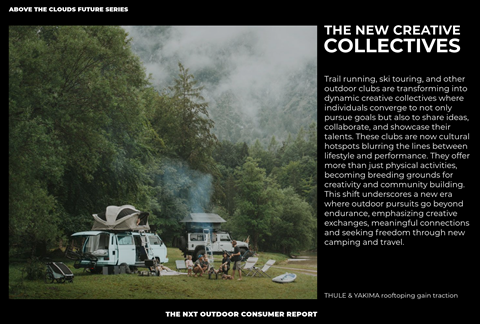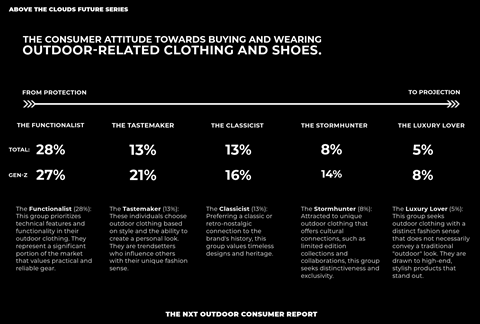In the rapidly evolving landscape of the outdoor and sports industries, a new cultural movement is emerging—The New Creative Collectives. These are not just groups of individuals gathering to participate in outdoor and sports activities; they are communities where creativity, culture, and sport converge to create something far greater than the sum of their parts. For brands aiming to future-proof their strategies, understanding and engaging with these collectives is crucial.

The rise of the new Creative Collectives
What began with urban running clubs has evolved into a broader phenomenon that now includes activities like ski touring, trail running, mountaineering, and gravel biking. These collectives are characterized by a few key elements:
1. Shared passion for activities: The core of these collectives is a deep-seated love for specific sports. Whether it’s the endurance challenge of gravel biking or the meditative quality of trail running, these activities are more than just physical pursuits—they are lifestyles. Members of these collectives’ bond over their shared passion, creating a strong sense of community and belonging.
2. Cultural and creative expression: The New Creative Collectives are also spaces of cultural and artistic innovation. Members often engage in creative endeavors inspired by their outdoor activities, whether that’s through photography, design, or music. This blending of sports and creativity defines the unique identity of these groups, making them not just participants in an activity, but creators of a culture.
3. Innovation and experimentation: These collectives are at the forefront of experimenting with how outdoor gear and apparel intersect with everyday life. This has led to the trend of performance wear being adopted as streetwear—yet this is just a byproduct of a deeper cultural shift. The true essence of The New Creative Collectives lies in their ability to innovate within their chosen activities and express their identities through their gear and apparel.
Understanding the Gorp Core archetypes
Integral to The New Creative Collectives is the Gorp Core trend, where outdoor clothing and gear transcend their functional origins to become symbols of lifestyle and identity. The NXT report identifies a spectrum of archetypes within the Gorp Core, each representing a different approach to how these collectives engage with outdoor gear:
- The Functionalist (28%): Focused on utility and performance, this group sees outdoor gear as essential tools for their activities. For Functionalists, gear must be reliable and durable, prioritizing practicality above all else.
- The Tastemaker (13%): Tastemakers are trendsetters who blend functionality with fashion, choosing outdoor clothing that allows them to express their personal style. They are influential within their communities, setting trends that others follow.
- The Classicist (13%): Valuing timeless designs and heritage, Classicists prefer outdoor gear that connects them to the past. Their participation in collectives is often accompanied by a respect for tradition and a classic approach to both gear and activities.
- The Stormhunter (8%): This group seeks distinctiveness and exclusivity, often drawn to limited edition or collaborative collections that offer cultural connections. Their engagement with creative collectives is tied to a pursuit of uniqueness within their community.
- The Luxury Lover (5%): Luxury Lovers are attracted to high-end, stylish products that stand out. They view outdoor clothing as a means of making a statement, blending performance with luxury in a way that reflects their status and taste.

Strategic implications for brands
For outdoor and sports industry leaders, the rise of The New Creative Collectives presents both opportunities and challenges. Brands that understand this trend can position themselves at the forefront of cultural innovation, while those that fail to engage risk becoming irrelevant.
- Embracing community and creativity: To connect with these collectives, brands need to go beyond traditional marketing tactics. This means engaging with these groups on a deeper level—sponsoring their activities, collaborating on creative projects, or providing platforms for them to share their stories. Brands that support the cultural and creative aspects of these collectives will build stronger loyalty and trust within these communities.
- Innovating with functionality and style: The New Creative Collectives are looking for gear that meets both their functional needs and their desire for self-expression. Brands should focus on developing products that are not only high-performing in sport and outdoor settings but also stylish enough to be worn in everyday life. This dual functionality appeals to both the practical and aesthetic sensibilities of these consumers.
- Telling authentic stories: Members of these collectives are drawn to brands that share their values and tell authentic stories. Brands should craft narratives that resonate with the experiences of these groups, highlighting the intersection of sport, creativity, and community. Authenticity is key—these consumers are savvy and can easily spot inauthentic branding.
Connecting with broader industry trends
The New Creative Collectives are not isolated from other key trends in the outdoor and sports industries; rather, they are deeply interconnected with them:
- Social connection and community building: The report highlights that 31% of consumers value outdoor activities for the social connections they provide. The New Creative Collectives are the embodiment of this trend, creating tight-knit communities around shared passions.
- Cultural influence and sustainability: These collectives are often aligned with broader cultural movements, including sustainability. While not their primary focus, many members of these groups are concerned with the environmental impact of their activities and gear. Brands that integrate sustainable practices into their product lines can deepen their connection with these collectives.
Strategic reflections: the path forward
The New Creative Collectives represent a significant opportunity for brands in the outdoor and sports industries to engage with a highly influential and culturally innovative audience. By understanding and embracing this trend, brands can position themselves at the forefront of a movement that is redefining sports and outdoor culture.
To succeed, brands must focus on supporting community and creativity on a local level to make waves in niche communities, innovating with products that blend functionality and style, and telling authentic stories that resonate with these groups. As the lines between outdoor activities and everyday life continue to blur, the brands that lead with these strategies will not only capture the hearts of today’s consumers but also future-proof their place in the market.
The future of the outdoor industry is being shaped by The New Creative Collectives—communities where culture, creativity, and sport intersect in powerful ways. Brands that recognize this shift and engage with it strategically will lead the way into a new era of outdoor culture.
Is your brand ready for the sustainable consumer?
Eco-conscious consumers are reshaping the sports and outdoor industry. Discover the latest trends and strategies to stay ahead in our special series.
>> Find out moreAbout the author Fredrik Ekström
Fredrik Ekström, a brand strategist and founder of Above The Clouds, brings over 20 years of expertise in consumer insights, brand development, and strategic communication. With a unique understanding of the evolving landscape of sustainability and consumer behavior within the outdoor and lifestyle industries, Fredrik unveils key findings from his latest report, THE NXT NORDIC OUTDOOR CONSUMER 2024. This report draws on data from 2,500 individuals across Sweden, Finland, Norway, and Denmark.








